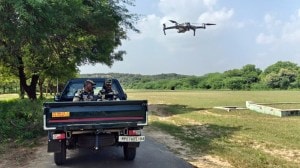Remembering Mahatma Gandhi, Bhagat Singh — the Green Way
FROM Mahatma Gandhi to Bhagat Singh, the memory of every icon connected with the Indian freedom struggle lives on in Balawadi village, 55 km...

FROM Mahatma Gandhi to Bhagat Singh, the memory of every icon connected with the Indian freedom struggle lives on in Balawadi village, 55 km from Sangli city in Sangli district. Not as the commonplace statues or icons, but as trees. A silent revolution to develop a ‘‘Kranti Van’’, a memorial to the freedom fighters, has taken root.
The man behind the movement is Sampatrao Pawar, 61. The son of a freedom fighter, Pawar, involved in social service since his college days, started the project about 10 years back. Feeling the ‘‘need for the youth to keep alive the dreams of freedom fighters’’, he came up with the idea of planting trees in their names.
Initially, Pawar faced some criticism from relatives and other villagers who mocked him for his ‘‘madness’’. But his persistence paid off. The villagers formed the Kranti Van Committee. In 1992, they sought the government’s permission to use a barren patch of land to plant trees. Although permission was granted then, six years later, the district administration dubbed the plantation ‘‘illegal’’. Villagers had to hand over about 1,475 trees to the government. Today, the patch of land stands neglected and the trees that were planted so painstakingly are all dying.
‘‘I wrote to District Collector Hanmantrao Pawar requesting him to hand over the plot to the Kranti Van Committee. But there has been no response,’’ says Pawar. The district collector was not available for comment.
Undaunted, Pawar donated two-and-half acres of his farm to the Kranti Van Committee in August 1999. Now, he plans to donate the remaining four acres also. On the personal front also, Pawar suffered a deadly blow. His 21-year-old son, Vaibhav, died while digging a well in Kranti Van.
‘‘The project has not drawn a single rupee from the government,’’ says Pawar, adding that about Rs 10 lakh has been spent on it so far. Today, 158 trees and over 5000 creepers stand on the plot of land. While 278 people donated Rs 1000 each, others contributed by providing free cement, construction material and machinery.
The project has drawn enthusiastic response from nearby villages as well. Kamlakar Rajguru, nephew of the revolutionary, Rajguru, planted a tree at the Kranti Van in his uncle’s name. On Sundays and holidays, students and residents of neighbouring villages descend on the place for camps and shramdaan.
Sharvari Ghatge, a Class XI student of Kirloskar Junior College in Kirloskarwadi town, five kilometres from Balawadi, has visited Kranti Van camps since she was in Class VIII. ‘‘I know good work is going on and we must contribute our bit,’’ she says.
Anna Jadhav, a young labourer from Alsand village, another five kilometres from Balawadi, agrees. ‘‘It is the finest way to pay back our debt to freedom fighters,’’ says Jadhav.
For the future, there are plans aplenty. ‘‘We aim to set up a nature school and a museum which will inform future generations about the Indian freedom struggle, especially heroes from this region who are not mentioned in history books,’’ says Pawar.
‘‘Mankind has exploited nature mercilessly. Now it is time for a healing touch,’’ adds Subrao Pawar, chairman of the committee.
Camps to inculcate the importance of social service in the youth and practical training in village development are also on the anvil. So is a ‘‘digital school’’ to train the youth in new technology.
But for all this, the organisation needs more resources. ‘‘We need more funds, but not from the government,’’ says Pawar, who has little faith in politicians as ‘‘they have swindled the people and failed democracy in this country.’’
Photos





- 01
- 02
- 03
- 04
- 05

























